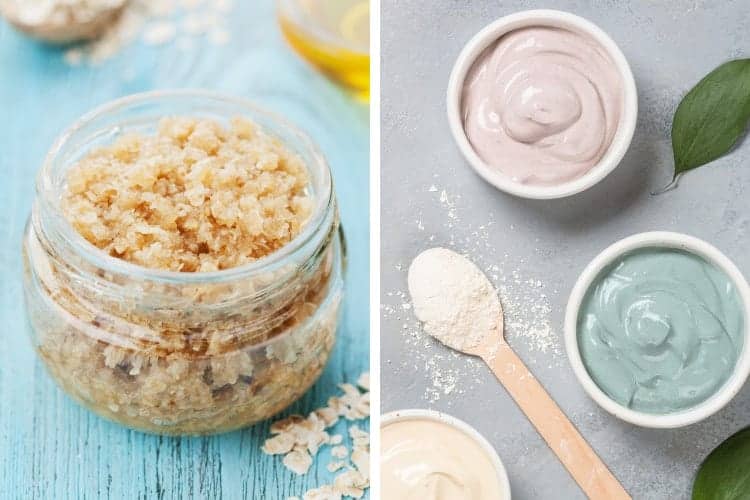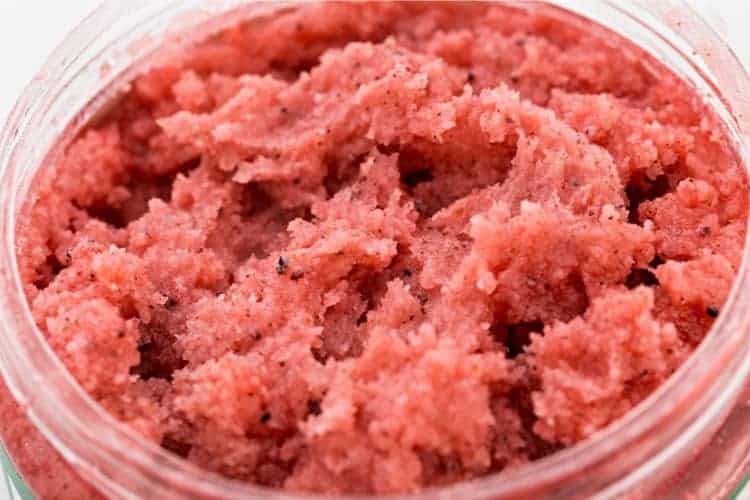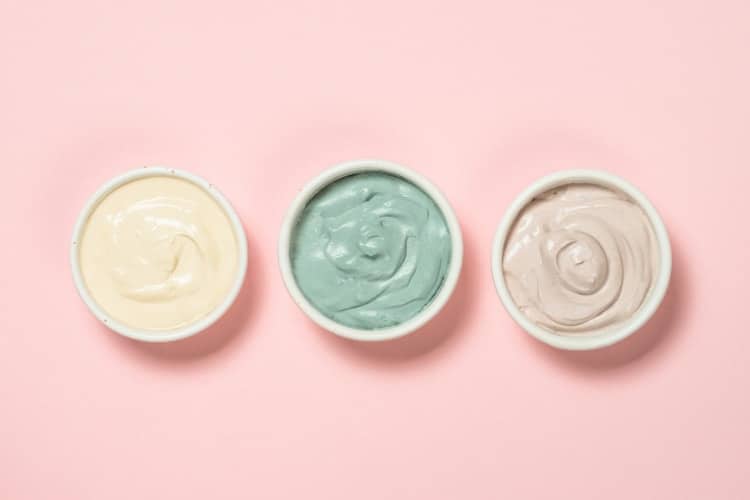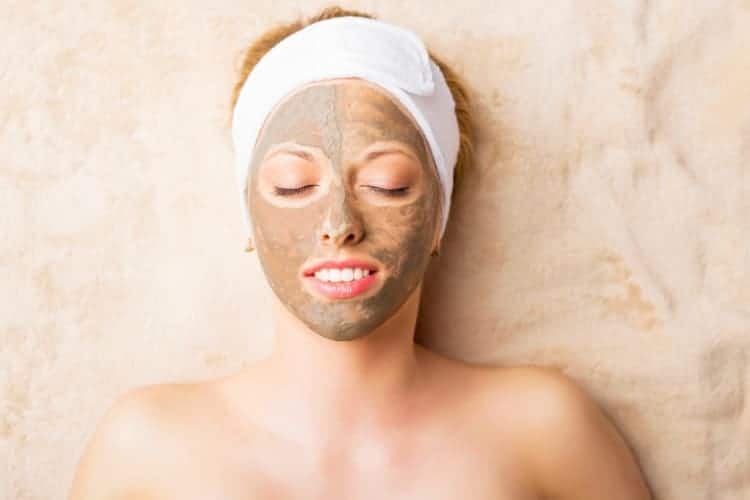
Scrubs and masks are staples in many people’s skin care routines. But what do these products actually do, are they really necessary and how should you use them to get optimal results?
Well, this guide is going to answer all of those questions – and much more – so that you can build a skin care routine that works for you.
But before we go any further, let’s address the topic of which is better: face scrub or face mask?
A face scrub is meant to lift off dead skin while a mask infuses the skin with nourishing or healing ingredients. In addition, most masks also have the ability to remove dead skin. This means that masks are often a better choice because you can achieve more with less steps in your routine.
Now that we have a basic understanding of what masks and scrubs do, let’s take a closer look at their additional benefits.
WHAT IS A SCRUB AND ITS BENEFITS

On average the skin has a 28-day renewal cycle during which it sheds old cells and makes room for new cells. Even though this process normally happens on its own, there are times when those old skin cells may not shed on their own. This is where a scrub can be helpful because it helps with exfoliation.
Simply put, exfoliation is the process of removing dead skin cells from the surface of the skin. And we want those dead skin cells gone because if they build up, they can:
- make the skin look dull, dry or flaky.
- contribute to clogged pores.
By exfoliating the skin, you get rid of those old cells, resulting in:
- a healthier appearance or glow.
- smoother skin.
- a more balanced skin tone.
- lesser clogged pores (which may also mean less pimples).
In addition, it’s also been suggested that regular exfoliation could even stimulate collagen production. This occurs mainly with scrubs that contain ingredients like alpha hydroxy acids, which seem to support collagen production (1, 2).
Now, in terms of types of scrubs, there are two main categories:
- Manual or Physical Scrubs: these are grainy scrubs and includes things like sugar, coffee, salt, loofahs, exfoliating mitts and flours (such as chickpea, rice or oat flour).
- Chemical Scrubs: these types of scrubs rely on specific chemicals to melt away dead skin cells. Examples of chemical scrubs include AHA (alpha hydroxy acids) such as lactic acid and glycolic acid, BHA (beta hydroxy acids) such as salicylic acid and retinoids.
Although they are quite popular, manual or physical scrubs can easily damage the skin. The rough grains contribute to teeny tiny tears in the skin.
On the other hand, chemical scrubs don’t have this issue, although they can irritate the skin if used too often or at very high concentrations.
HOW TO USE A FACE SCRUB OR EXFOLIATOR

1. Cleanse first
It’s best to wash your face before using a scrub. This ensures that your skin is free of makeup, sweat and surface dirt, allowing scrub or exfoliator to be more effective.
2. Apply a mask
After scrubbing your face, you can follow up with your favorite face mask.
Choose a clay mask to help reduce oiliness and acne, or go for a hydrating mask if your skin is looking and feeling dull.
3. Tone and hydrate
Now that you’ve cleansed, scrubbed and masked, it’s time to restore balance to your skin.
A gentle toner and pH balancer like rose water is an excellent option. Not to mention rose water also hydrates the skin.
4. Nourish and moisturize
The final step in your post-scrub routine is to apply a serum, followed by a moisturizer or face oil.
5. Scrub once or twice a week
Whether it’s a physical or chemical scrub, over-exfoliation will damage your skin.
So, make sure to give your skin a break and only exfoliate once a week (for manual scrubs) or up to twice a week (for chemical scrubs).
6. Choose an appropriate time of day
While you can exfoliate at any time of day, some experts – such as Dr. Phoenyx M.D. – suggest adapting your exfoliation schedule to your lifestyle and your current skin care routine.
According to Dr. Phoenyx, you should exfoliate in the:
- morning if you workout in the morning and you don’t wear any makeup.
- evening if you workout in the mornings and you wear a full face of makeup every day.
WHAT IS A FACE MASK AND ITS BENEFITS

The purpose of a face mask is to give the skin a quick and intense dose of one or more active ingredients. Overall, masks can help to:
- hydrate or moisturize the skin.
- soften fine lines.
- soothe redness.
- shrink acne.
- improve hyperpigmentation.
- reduce oiliness.
Whether it’s dermatologists or doctors at institutions like the Cleveland Clinic and University of Pennsylvania, most agree that face masks do in fact work (3, 4, 5). But the question is which type of mask should you use?
Well, here’s a quick overview of the different types of masks that you find on the market:
- Sleep or Overnight Masks: these are meant to remoisturize and re-nourish the skin. They tend to be quite thick and contain hydrating ingredients like glycerin or hyaluronic acid. Overall, these are great for all skin types, particularly dry and mature skin.
- Clay Masks: made from ingredients like bentonite, rhassoul or kaolin clay, these are excellent for oily or acne prone skin.
- Korean Sheet Masks: these are face-shaped sheets that are saturated with active ingredients like humectants, ceramides and antioxidants. Although their main purpose is hydration, some also focus on exfoliation, soothing inflamed skin, balancing skin tone, reducing shine, smoothing fine lines and so on (source).
- Gel Masks: formulated to hydrate and nourish the skin, these masks provide a cooling effect that is soothing to dry, delicate skin (though other skin types can still enjoy the benefits).
- Peel Off Masks: these are enriched with ingredients that can exfoliate, hydrate and clean pores. This type of mask is applied in a liquid or wet form and then allowed to dry to a thin film. Suitable for most skin types, except very sensitive skin.
- Cream Masks: these are quite heavy in texture and rich in ingredients that prevent moisture loss (such as oils). Ideal for normal to dry skin, as well as mature skin.
- Exfoliating Masks: formulated to remove dead skin and to clean pores. These masks rely on ingredients like AHA, BHA and fruit enzymes. They can be drying and are ideal for oily and normal skin.
HOW TO USE A FACE MASK

1. Cleanse and scrub first
If you wear makeup, it’s essential that you wash your face before applying a mask.
Follow that up with a scrub or exfoliator of your choice.
2. Apply mask
Although you can use a mask at any time of day, consider switching things up as follows:
- Apply hydrating masks in the morning. Since this type of mask plumps up the skin and gives a natural glow, it’s the perfect way to start your day.
- Use detoxifying or exfoliating masks in the evening since they tend to include ingredients that increase photosensitivity.
3. Balance and tone
After rinsing off your mask, apply your favorite toner or astringent.
4. Moisturize
The last step in your post-mask routine is to moisturize. You can do this by using one or more of these:
- serum.
- moisturizer.
- face oil.
5. Use a mask once or twice a week
Since masks are an intense treatment, they’re meant to be used occasionally – once or twice a week – rather than every day. This is especially true for clay masks, detoxifying masks and exfoliating masks.
Here are some simple guidelines to keep in mind based on your skin type:
- Oily skin: you can get away with using clay masks one to three times a week.
- Oily and sensitive skin: you might be able to use a bentonite clay mask once a week. For gentler clays like kaolin, you can try twice weekly applications. Be careful with masks that contain AHAs, BHAs or retinoids. Even at low concentrations, these ingredients can be too much for sensitive skin.
- Dry and sensitive skin: use a hydrating mask once a week. If you want to try clay, stick to kaolin since it’s the most gentle.
- Dry and not particularly sensitive: consider using a hydrating mask several nights a week. As for clay masks, you can try a gentle kaolin mask once a week. Avoid masks that contain strong ingredients like AHAs, BHAs or retinol.
- Mature skin: mature skin tends to be dry and will follow the same general guidelines as dry skin.
FAQs ABOUT FACE SCRUB VS FACE MASK
What are the disadvantages of scrubs and masks?
The main risk with scrubs and masks is irritation. For example, a rough and grainy scrub can scratch and damage the skin. In addition, ingredients in chemical scrubs and face masks may cause irritation if used too often.
Are DIY face scrubs safe?
If they’re made with ingredients that are clinically proven to be safe or ingredients that have historically been used for skin care, DIY scrubs can be quite safe. One thing to keep in mind is that many DIY scrubs use food or herbs. So, if you’re allergic to a particular item, then you want to avoid putting them on your skin.
Can I use a DIY mask everyday?
The ingredients in your DIY mask will determine how frequently you can use the mask. For example, if you’re making a hydrating mask out of honey and/or fresh aloe vera gel, you can generally use it daily.
However, if you’re making a mask with citrus essential oils that increase sun sensitivity, then you’re better off using those less frequently.
CONCLUSION
Masks and scrubs serve different purposes in a skin care routine. Some people benefit from using just one or both.
Also, many masks contain chemical exfoliants. This means you could skip scrubs altogether and get the same benefits from a good quality exfoliating mask.
So, you could very well decide to use a mask that has one of these exfoliating ingredients.
It would mean one less step in your skincare routine!
No matter how you choose to go about it, I hope this article has helped you better understand the world of scrubs and masks.

You Might Also Enjoy:
What To Do Before And After Steaming Your Face: A Complete Guide
The Difference Between Rose Water and Micellar Water: A Complete Guide
How to Exfoliate Sensitive Skin Naturally: 8 Amazing Ingredients and How to Use Them
Honey Mask vs Clay Mask: Benefits, How To Use and Recipes
5 Things To Know Before Using Clay for Dry Skin (+ Bonus Recipe)
Kaolin Clay Mask for Dry Skin: Benefits and Tips For A Healthy Glow

